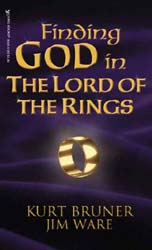|
Finding God in the Lord of the Rings by Kurt Bruner and Jim Ware Reviewed by Joe Westbrook |
|
With the recent arrival of the films based on J.R.R. Tolkien’s classic work, it is understandable that books about the books have arisen. In Finding God in The Lord of the Rings, Bruner and Ware explore several scenes/events from the books and examine the relationship to the Bible, Christianity, and the Christian walk. True, there are parallels that can be drawn, and according to materials Tolkien wrote that are referenced in the epilogue of this book, that was part of Tolkien’s intent. According to The Tolkien Society (www.tolkiensociety.org) J.R.R. Tolkien was a devout Catholic, so this shouldn’t be entirely surprising. A person who is devout to any religion should have aspects of those beliefs coming into play in all that he or she does. While I have only read the excerpts supplied by the authors, what they have provided tells me that their approach to their book is at least somewhat justified. They tell readers in the epilogue that they wrote their book from a Christian perspective, and I have no reason to believe that their intentions were anything but noble. The comparisons that Bruner and Ware draw could be used as a springboard into spiritual discussion with an unbeliever. Many people of all ages have seen the movies, so it should be easy to say, “Remember the scene where ___________ happened? Well, that’s very similar to the Bible where ____________ happened.” There will obviously be differences between the Bible and Tolkien. For instance, I have heard the argument that Frodo represents Christ. Sure, Frodo carries the Ring to the place where it will ultimately be destroyed and it is basically his sole responsibility to see the quest through to the end. This is like Christ bearing our sins on the cross…no one else could have done it. However, like all analogies pertaining to Christianity, the parallel breaks down when Frodo decides he wants to keep the Ring for himself. Even Frodo could not ultimately resist the sway of the Ring, while Christ never faltered in His resisting the Devil and abstaining from sin It is vital to keep this in mind when using anything other than the Bible to explain the Bible. Personally, I would hesitantly suggest using such a method to approach evangelism. Using sources outside the Bible can lead to confusing the unbeliever as to what you are really trying to say. Instead, I would suggest following the method used by Ray Comfort and described in his book Hell’s Best Kept Secret. Briefly, the method involves starting a conversation with a person to be able to relate to them on some level that doesn’t involve spirituality (which, admittedly, could stem from a movie or book, like The Lord of the Rings). This is followed by finding out where the person is spiritually, which leads to a discussion of concepts such as the existence of God, how good a person has to be to go to heaven (or how bad a person has to be to go to hell). Next, you can use the Law to show that there is not one person who is able to meet God’s standards on their own and that the person you are talking to is desperately in need of salvation. Finally, you can show them that what Christ did is the only sufficient method for salvation. There is only one source of divine revelation – the Bible. We have been given it to know the Lord and to tell others of Him. Our first thought should be to use it before the fallible and often misleading sources of men. (01/17/06) |
|
Rating: (8 out of 10) About the Author |
